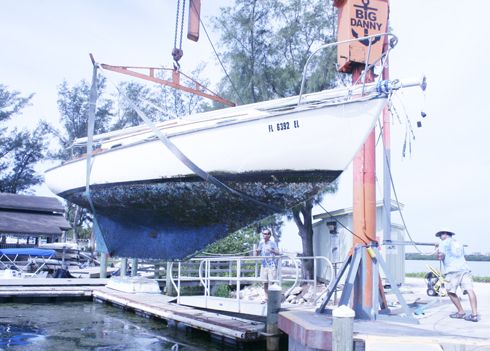
Practical Sailor owes a debt of gratitude to Sarasota, Fla., sailor Mike Collins, who offered his Cape Dory 25,Skimmer, as a test platform for a new environmentally friendly bottom paint earlier this year. The paint had done well early in our panel testing, and Collins, who oversees the health of the aquariums at Mote Marine Laboratory in Sarasota, was as curious as we were to see how it might perform on a hull. So how did it do? This photo of Skimmers bottom, taken just six months after the bottom was painted, says it all.
It is important to point out that the paint, Sea Hawks Smart Solutions, was an early formulation of an antifouling coating that contains no metal, not even the relatively benign zinc that other green paints rely on to fight barnacles. Designed for application by a professional, Smart Solutions is a specialized formula for low- to moderate-fouling areas. Sea Hawk would not normally recommend the paint for people like Collins who sail in warm waters known for heavy fouling, but they gamely agreed to participate in our test as it was being carried out in conjunction with our test of ultrasonic antifouling. The formula that Collins applied in February has since been modified, and although we have not yet tested the newer blend, Sea Hawk reports that it is getting better results.
This isn’t the first time Collins, an avid club racer out of the Sarasota Sailing Squadron, has sacrificed a slick hull for PS readers. Two years ago, Interlux introduced its new Pacifica blend, a formula designed to meet strict environmental rules that were being introduced on the West Coast. Shortly after Skimmers slick Pacifica-blue bottom splashed into the bay, Interlux announced the introduction of (ta-da!) Pacifica Plus. The original formula, as Collins soon found out, lacked the sort of punch Interlux had observed in early testing. That Collins agreed to be a guinea pig again is testimony to his commitment to the copper-free cause.
We are often asked about new eco-friendly alternatives to copper-based antifouling paints, and our rule of thumb with these new paints is to wait to buy it until the paint has been on the market for two seasons. This allows time to gauge other boaters experiences with the new blends and see how the paints do in Practical Sailor‘s testing. Although these paints go through extensive trials prior to their introduction to the market, weve seen some game-changing eco-paint flop after less than 12 months in the water. With rare exception, only those paints that contain cuprous oxide have fended off barnacles for longer than 18 months in our testing.
In the most recent round of testing after nine months, the blends boosted by the newest magic bullet-the “green” pesticide Econea-are delivering Fair to Good protection, well below their copper-fortified peers. One new paint that is doing well is a reformulated blend of Epaints SN-1, an aluminum-friendly, two-part paint that requires professional application.
Interestingly, the same Smart Solutions formula that Collins had on his boat is still barnacle-free in our panel testing, which is carried out at a dock near where Collinss boat is moored. We still don’t have an explanation for this, but Sea Hawks experts suggested that since this early formula was softer than the newest blend, the coating may have worn-away faster on Collinss boat that on our panel. Skimmer also sees more sunlight on its mooring than our panels do.
Although we are not fans of the growing movement to ban or sharply reduce copper in bottom paints for well-flushed marine environments, we are glad to see that companies like Eco-Clad, Epaint, Flexdel, Interlux, Luritek, Pettit, and Sea Hawk are exploring new formulas that can help to reduce boaters environmental impact.
As for Collins, his commitment to the anti-copper cause is on pause for the moment. Once the barnacles were scraped clean from Skimmerthis time, he opted to apply Biocop TF, one of Sea Hawks high-copper blends specifically formulated for high-fouling waters. Well check in again in six months to see whether hes still smiling.





































